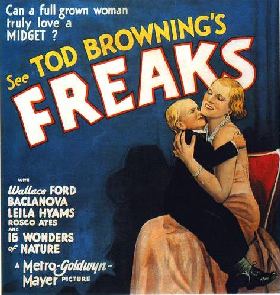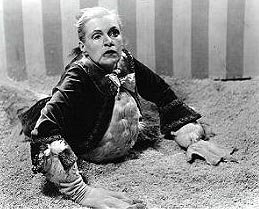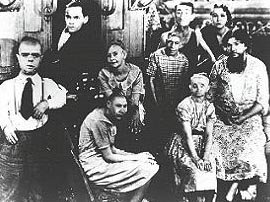In Memoriam: Freakmaster T

Tod Browning was famous for directing Dracula, but I've always preferred his later film, Freaks. As a young man, Browning ran away to join a carnival, and worked in a freak show. In Freaks, he pays tribute to this strange community, using many of the famous freaks of the day and setting the story in a carnival. The film is a simple morality tale: a wealthy midget, Hans, falls in love with Cleopatra, a trapeze artist, and rejects his midget fiancee. Cleopatra, of course, is a heartless virago who marries Hans for his money, cuckolds him with the strong man, and tries to poison him. His fellow freaks kill the strong man and mutilate Cleopatra, turning her into a half-woman, half-chicken creature. Needless to say, the film was a bit much for audiences of the day, who widely ignored it. Even worse, it was banned in Great Britain for thirty years.

On the surface, the film seems to be a plea for understanding for society's unfortunates, as it showed the freaks socializing, joking with each other, and living lives of amazing normalcy.

On the other hand, the final scene, in which the freaks crawl through mud and a driving rainstorm, clutching knives and other weapons, is horrifying. Browning, in short, tried to exploit the freaks for horror, while asking the audience to recognize their basic humanity.

Until this summer, I never really understood why this didn't work. For years, I've searched out freakshows. Nowadays, most naturally-born freaks are healed in childhood, or are prescribed therapies that hide their oddness. For example, siamese twins are separated at birth, people with missing extremities or facial deformities have them reconstructed, and women with beautiful beards are given hormones to correct their imbalances. In short, all the really cool freaks have been healed. Todays sideshows fall into one of two categories: professional freaks and fame-hungry attention whores. In the first category, we have things like the Coney Island freak show, or the Jim Rose Circus Sideshow, which feature trained performers who have learned how to chew lightbulbs, eat swords, pump out their stomachs, absorb huge amounts of electricity, or dozens of other amazing and disgusting feats. Watching these people is like viewing a sleazy version of Cirque de Soleil--you are both amazed and repulsed. If you are like me, you find yourself entertaining dreams of running away with the circus.
The second form of sideshow, which features attention whores, is largely the purview of television. In many ways, this began with The Jerry Springer Show, Michael Bey, and all the other sleazy daytime TV hosts. Day after day, these shows drag out the absolute dregs of humanity, walking bags of pus that combine insatiable and often unexplainable sexual appetites with a new-age derived sense of entitlement, ensuring that every word that drips from their filthy, coldsore-encrusted cakeholes is heavily dosed with unintentional irony. However, as fun as this sort of program is, the producers (and the networks) seem to have realized that it can only go so far. After a point, even the festering petri dish of sub-humans that make up the regular audience for these shows have grown tired of the "she-done-took-my-man-and-I'm-givin'-the-bitch-a-smackdown-even-if-she-is-my-mother" formula.
A couple of years ago, someone hit on a piece of inspired wisdom. Simply put, it goes like this: In America, there are people who will do anything (and I do mean anything) for a few paltry minutes of glory. They will go through any challenge and eat any substance, just to get the opportunity to slurp on the teat of momentary fame. Let me put this in historical perspective: in the freakshows of yesteryear, there was one person that everyone looked down upon. This person didn't have any physical deformities or particular skills. Rather, he or she made a living through simple depravity. The Geek, as this particular freak was called, was usually a hard-luck alcoholic or mental defective, and he or she would lie in the mud with snakes, bite the heads off live chickens, and generally display the sort of behavior associated with savage barbarians, the French, and (of course) Ozzy Osborne.
Today, of course, the Geek would be out of luck. After all, who needs a Geek when so many people are so willing to degrade themselves for a few bucks and a chance at fame and fortune?
Anyway, back to my point. Every summer, a state fair comes through town, and I try to go a few times. One of the regular attractions is an animal freak show, featuring "The World's Largest Pig," "The World's Smallest Horse," and "The World's Oldest Alligator." One year, it even had "The World's Largest Rat," which was actually a capyberra housed in a bright green dumpster. Granted, these aren't all that exciting, but I give them a couple of bucks anyway--I appreciate the showmanship.
This year, there was a new kid on the block. Titled "West Indies Cultural Exhibition," it promised "The World's Smallest Woman." Expecting a fun fraud, I forked over my buck and walked around back, where I found a gray-haired black midget seated in a chair, watching TV and drinking cold beers. She looked over, gave me a smile, and said, "I'm sixty years old and 22 inches tall." I smiled, trying to think of a nice reply when I was saved by the next visitor, a little girl. The midget smiled and began talking to the child, who immediately warmed to her. I dropped another dollar in the tip jar and left.
My immediate feeling was shame, but it was quickly replaced by envy. This woman's job, as far as I could tell, was sitting in an air-conditioned trailer, enjoying soap operas and beer. In return for this, she was compensated quite well. In fact, a little quick calculation told me that she was probably making more that I do. A lot more. Best of all, most of her customers were probably, like me, ashamed of their curiosity, which meant that she didn't have to deal with too much conversation, as they most likely slunk away with a minimum of eye contact.
And then it occurred to me: American society needs a return of the good old-fashioned freak show. While it may seem politically incorrect to pay money to see physical deformities, I'm not sure how doing so is qualitatively different from paying supermodels to do their little turn on the catwalk. In both cases, the person in question has gotten an unusual spin on the genetic lottery. For the supermodel, the outcome is freakish beauty, while the freak gets deformity. In both cases, the end result is potentially lucrative. In fact, rather than protecting freaks, I think that our current system puts them at an economic disadvantage.
I must admit that this idea is not completely altruistic; in fact, it's based in my love of my community. The other day at Wal-Mart, I found myself stuck in line between three people who, with a minor amount of creative makeup and hairstyling, could make an excellent living on the freakshow circuit. If they did so, it would probably make them a great deal more money than they are currently pulling down, which would, in turn, help the local economy. As things stand, one of the few natural resources currently available in Appalachia is freaks--a shallow gene pool and a laissez-faire approach to dentistry have produced some truly amazing people in my area alone. I can only imagine what some of the more remote places have to offer. It's time to let these people cash in.








0 Comments:
Post a Comment
Subscribe to Post Comments [Atom]
<< Home